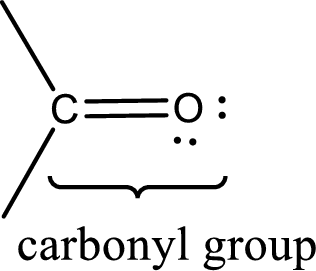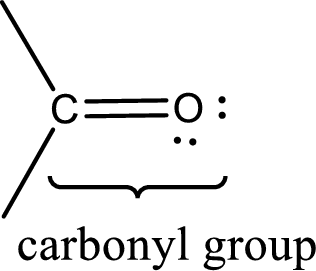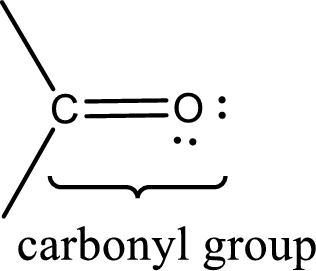
(a)
Interpretation:
Structural formula of thioformaldeyde has to be drawn.
Concept Introduction:
Carbonyl groups are the one which contain a double bond between carbon and oxygen atom.

If either of the carbon atom or the oxygen atom present in the carbonyl group is substituted by sulfur atom means it is known as sulfur-containing carbonyl compounds.

(b)
Interpretation:
Structural formula of methanethial has to be drawn.
Concept Introduction:
Carbonyl groups are the one which contain a double bond between carbon and oxygen atom. Aldehydes and ketones possess this carbonyl functional group in it. The structural representation of a carbonyl group can be given as shown below,

If either of the carbon atom or the oxygen atom present in the carbonyl group is substituted by sulfur atom means it is known as sulfur-containing carbonyl compounds.

(c)
Interpretation:
Structural formula of thioacetone has to be drawn.
Concept Introduction:
Carbonyl groups are the one which contain a double bond between carbon and oxygen atom. Aldehydes and ketones possess this carbonyl functional group in it. The structural representation of a carbonyl group can be given as shown below,

If either of the carbon atom or the oxygen atom present in the carbonyl group is substituted by sulfur atom means it is known as sulfur-containing carbonyl compounds.

(d)
Interpretation:
Structural formula of propanethione has to be drawn.
Concept Introduction:
Carbonyl groups are the one which contain a double bond between carbon and oxygen atom. Aldehydes and ketones possess this carbonyl functional group in it. The structural representation of a carbonyl group can be given as shown below,

If either of the carbon atom or the oxygen atom present in the carbonyl group is substituted by sulfur atom means it is known as sulfur-containing carbonyl compounds.

Want to see the full answer?
Check out a sample textbook solution
Chapter 4 Solutions
Organic And Biological Chemistry
- Amide formation involves which two functional groups? A.carboxylic acid and alcohol B.alcohol and ketone C.carboxylic acid and amine D.amine and alcoholarrow_forwardWhat kind of solvent ingredients is widely is usually used in mouthwash, perfumes and spray A. Ethly acetate B. Aliphatic alcohols C. Fragrant esters D. Phenols and phenol derivativesarrow_forwarda. formaldehyde b. acetone c. benzaldehyde d. acetophenone which among the 4 samples contains the aldehyde group, which among the 4 samples does not contain the aldehyde group? Explainarrow_forward
- Mestranol, sold under the brand names Enovid, Norinyl, and Ortho-Novum among others, is an estrogen medication which has been used in birth control pills. Select all of the functional group families, to which mestranol belongs. Choose one or more: A. Ester B. Alkene C. Ether D. Thiol E. Alcohol F. Arene G.Aldehyde H.Ketone I. Alkynearrow_forward1. This structure will form when a hydroxyl group form a bond with a carbonyl group. a.Aldehyde b.Alcohol c.Hemiacetal d.straight chain formationarrow_forwardA chemist wants to make an ester from conversion of alcohol or phenol, what can he used? a. benzamide b. acetic anhydride c. maleic anhydrate d. nonearrow_forward
- This carboxylic salts are effective ingredient against yeast and molds in beverages, jams, pie fillings and ketchup a. benzoates b. sorbates c. acetates d. propionatesarrow_forwardAcid hydrolysis of ------------ produces carboxylic acids. a. Cyanides b. Alcohol c. Ester d. Hydrocarbonarrow_forwardOdour given when butyric acid react with isoamyl. Odour given when acetic acid react with isoamyl. Odour given when salicylic acid reacts with methanol Odour given when ethanol acid react with cinnamicarrow_forward
- Amide hydrolysis in basic conditions forms A. a carboxylic acid and an amine B. a carboxylate salt and an amine 3. an ester and an amine 4. a carboxylic acid and an amine saltarrow_forwardWhat are the major products of the reaction of ethyl benzoate with hydrochloric acid and water? a. benzoic acid and ethanol b. phenylic acid and ethanol c. ethanoic acid and benzene d. acetic acid and toluene e. phenylic acid and methanolarrow_forwardThe substance formed on addition of water to analdehyde or ketone is called a hydrate or a...a.) geminal diolb.) vicinal diolc.) acetald.) ketalarrow_forward
 Chemistry for Today: General, Organic, and Bioche...ChemistryISBN:9781305960060Author:Spencer L. Seager, Michael R. Slabaugh, Maren S. HansenPublisher:Cengage Learning
Chemistry for Today: General, Organic, and Bioche...ChemistryISBN:9781305960060Author:Spencer L. Seager, Michael R. Slabaugh, Maren S. HansenPublisher:Cengage Learning
